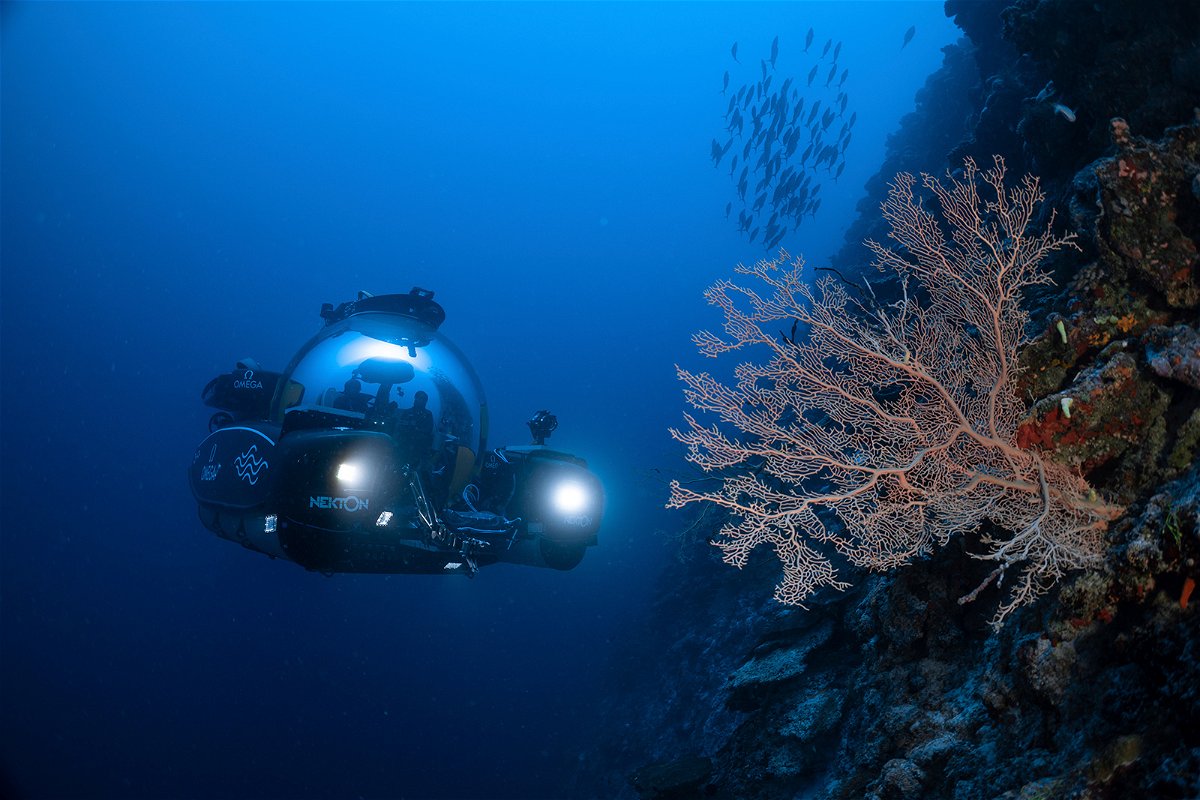The search for 100,000 new species in Earth’s oceans

Scientists use deep-sea submersibles to examine coral reefs off the Maldives in September 2022 as part of a mission to gain insights on the impact of carbon emissions and overfishing.
By Ashley Strickland, CNN
In some ways, Earth’s oceans are as alien to us as distant moons in the solar system.
The vast bodies of water cover more than 70% of our planet and include mysterious regions like the “twilight zone,” where an extraordinary number of species thrive beyond the reach of sunlight — and few researchers have ventured.
When scientists dived to the twilight zone and the mesophotic zone directly above it in recent years, they found colorful fish and sprawling pristine coral reefs.
Now, technological innovations are helping scientists unlock this little explored deep-sea ecosystem in a fast-changing world.
Ocean secrets
Researchers are hoping to shine a light on hidden marine life with an ambitious project called Ocean Census.
The global initiative seeks to find 100,000 unknown species over the next 10 years. While scientists believe 2.2 million marine species exist in Earth’s oceans, they estimate that they’ve only found 240,000, according to Ocean Census.
Identifying new species also enables conservationists to find ways to protect them as Earth changes due to the climate crisis.
Scientists warn that the climate crisis could reduce twilight zone species by between 20% and 40% before the end of the century — and if greenhouse gas emissions aren’t curbed, recovery could take thousands of years.
See some of the other species at risk of disappearing due to the climate crisis.
Fantastic creatures
Photography and documentaries take us into the visually stunning world of the animal kingdom, but sounds like birds chirping are just as key to our understanding of how various creatures live.
The first published recording of an animal was released in 1910 by the Gramophone Company Ltd., allowing people to listen to a nightingale’s song at home.
The recording is one of more than 250,000 artifacts within the wildlife collection at London’s British Library, which has a new exhibition called “Animals: Art, Science and Sound.”
The exhibit includes the call of the last male Kauaʻi ʻōʻō, a songbird from Hawaii, as he sings for his lost mate.
Defying gravity
The Japanese Hakuto-R lunar lander likely crashed into the moon during an attempt to make history Tuesday.
A successful ending to its three-month trek would have marked the world’s first lunar landing of a commercially developed spacecraft. But the mission control team lost contact with the robotic vehicle just before it was supposed to touch down on the moon.
The lander was also carrying the Rashid rover, the first Arab-built lunar spacecraft, which was designed to explore the Atlas Crater.
Separately, mission designer Zhang Rongqiao revealed why China’s Zhurong rover on Mars fell silent. The rover has been hibernating for nearly a year after an “unpredictable accumulation” of dust halted the mission.
Across the universe
Black holes gobble up anything in space that dares to come too close, but some are messier than others.
Scientists used 3D computer models to simulate the eating habits of these voracious space objects. Surprisingly, an elusive type of black hole dragged a star into its orbit and took a big bite out of the star each time it passed. Then, the black hole tossed the remnants of the star across the galaxy like a discarded apple core.
A separate team of astronomers also captured a groundbreaking new image of a black hole releasing a jet of material into space.
Meanwhile, scientists think they may have determined what triggers quasars, the brightest and most powerful objects in the universe.
Force of nature
The Greek island of Santorini is known for its picturesque whitewashed buildings with blue adornments and glimmering sunsets over the Aegean Sea. But the popular tourist destination also sits on a live volcano that’s part of a volcanic chain.
Just 5 miles northeast of Santorini lies one of the East Mediterranean’s most active underwater volcanoes. Called Kolumbo, it last erupted in 1650, and geologists warn that it’s only a matter of time before another eruption occurs.
Scientists have monitored and studied Kolumbo for years to determine how soon or distant that eruption may be.
Extreme conditions in the volcano’s crater are helping NASA prepare to investigate alien oceans on the moons of Jupiter and Saturn.
Take note
Linger a little longer over these intriguing stories:
— Elephants have lost a significant part of their habitat across Asia due to humans, which could lead to challenging encounters between the two populations.
— Before NASA’s InSight mission ended in December, the lander tracked seismic waves as they traveled through the center of Mars, revealing secrets about the red planet’s interior.
— Archaeologists studying Mexico’s Chichen Itza site recently uncovered what they believe to be a 1,000-year-old scoreboard the Maya used for a soccer-like game.
The-CNN-Wire
™ & © 2023 Cable News Network, Inc., a Warner Bros. Discovery Company. All rights reserved.
Like what you’ve read? Oh, but there’s more. Sign up here to receive in your inbox the next edition of Wonder Theory, brought to you by CNN Space and Science writers Ashley Strickland and Katie Hunt. They find wonder in planets beyond our solar system and discoveries from the ancient world.

